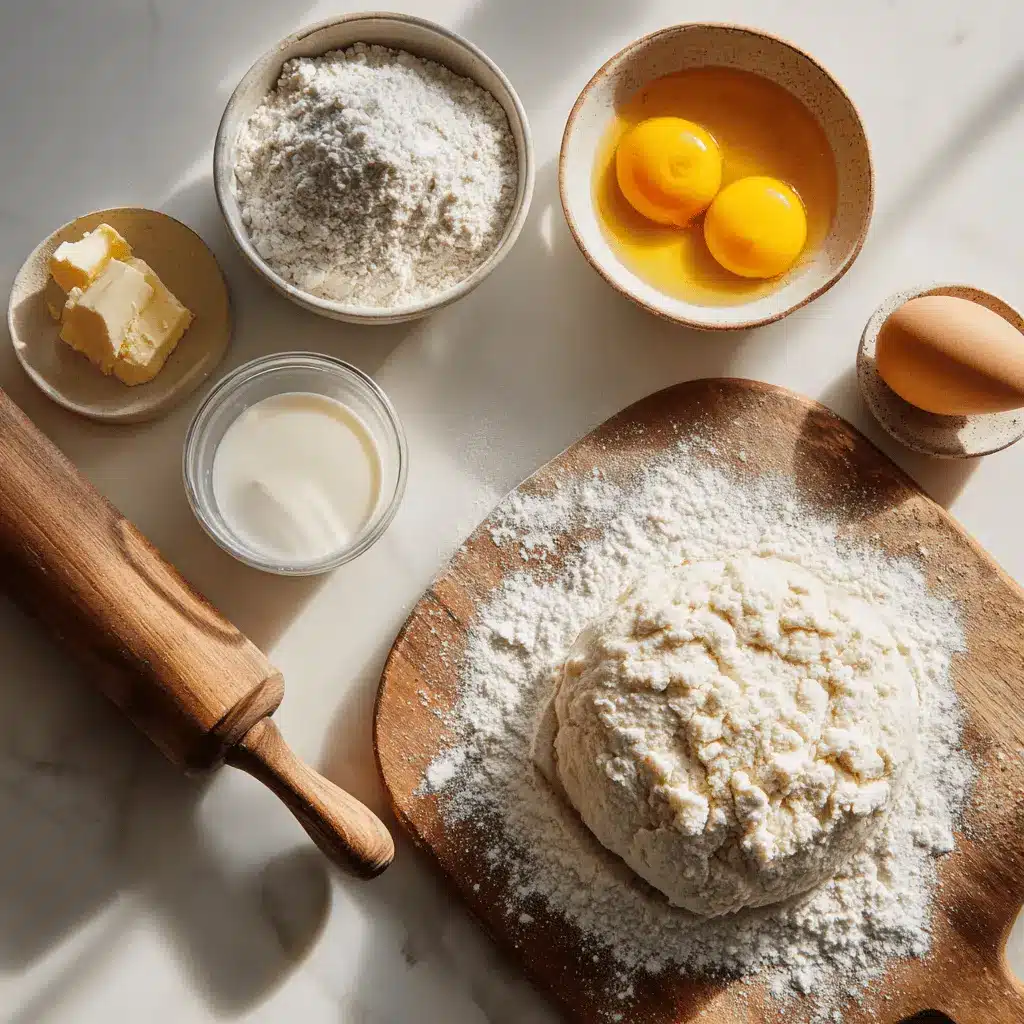Ever notice how the scent of melting butter and warm flake-y pastry can rewind time? These flaky sourdough croissants smell like quiet Sunday mornings and sound like Pinterest dreams. They’ve been popping off on TikTok—because who doesn’t want buttery layers at home? Not hard to make, just takes patience, love, and maybe a little flour on your floor.
It’s a homemade croissant kind of day. Just butter, flour, salt—and that bubbly sourdough starter from the back of your fridge. Nothing wild. Feels a bit like that bakery treat you always order, but made with your two hands. Full details in the blog!
I learned to fold pastry with floured fingers beside my grandma’s kitchen sink. She’d hum while rolling dough, no timer in sight—just feel. I’ve baked dozens since culinary school, but this version’s got a twist she’d love. I tested it. You’ll love the secret!
Why You’ll Love This Recipe
There’s just something magical about flaky sourdough croissants. The tangy kick from that slow-rising sourdough starter paired with buttery, golden layers? Utter perfection. These croissants transform simple mornings into café-worthy experiences—no fancy plane ticket to Paris required.
Making croissants at home might sound intimidating, but trust me—it’s an act of love. With each fold and roll, you’ll feel like an artist. And when that warm, flaky pastry comes out of the oven? You’ll be looking for excuses to invite friends over just to humblebrag, “Oh, these? I made them.”
The Ingredients & Tools You’ll Need

To nail these croissants, start with your foundation: active sourdough starter. A bubbly, fresh starter is key for that signature tang and rise. Combine it with strong white flour for structure, high-quality European-style butter (for richer layers), and just a touch of sugar and salt—you’ve got yourself a winning dough.
Grab a stand mixer with a dough hook to save your arms, and if possible, a stainless steel rolling pin for smooth, even pressure during lamination. Don’t forget tools like a pastry brush for that golden egg wash and parchment paper for stress-free butter handling.
Pro Tip: Soften your butter to the perfect pliable stage before laminating—too soft, it’ll squish; too cold, it’ll shatter. That sweet spot makes all the difference.
Step-by-Step Process Made Simple
The art of croissant-making boils down to lamination—the layering of dough and butter. Start by mixing and kneading your détrempé (the dough base) until it’s smooth and elastic. After proofing, roll it out to encase a perfectly squared sheet of butter. From there, it’s all about folding: tri-folding the dough three times with chilling breaks in between to ensure defined layers.
On shaping day, the dough is rolled thin and cut into triangles before being rolled into iconic crescents. Give them a gentle final proof, bake until gloriously golden, and—you’ve got melt-in-your-mouth flaky sourdough croissants.
Pro Tip: Keep your workspace cool during lamination! Warm kitchens can make the butter melt, which we definitely don’t want.
Troubleshooting Common Challenges
Worried about potential hiccups? Let’s tackle them! If your dough tears during rolling, it may be too cold—let it relax for a few minutes. Butter leaking out while baking often happens when the butter wasn’t properly chilled before folding. Keep it firm, but workable.
Uneven layers? Dust off excess flour and roll evenly without squishing the dough. It’s okay if it’s not perfect—practice makes progress. Still, those first flaky triumphs will taste just as good as perfect ones!
Pro Tip: If your croissants are proofing too slowly in a chilly kitchen, create a steamy environment in the oven using a bowl of hot water. This helps them puff without drying out.
Creative Add-Ons & Storage Tips
Want to jazz up your croissants? Spread chocolate chips or almond paste onto the dough triangles before rolling for a delightful surprise inside. Double the dough recipe and freeze extras after shaping—so you can pop them in the oven anytime buttery cravings hit.
Once baked, let croissants cool completely before storing in an airtight container for up to two days. To revive their flake, give them a quick warm-up in a 350°F oven for 5 minutes. But let’s be real—they probably won’t last that long!
Pro Tip: Freeze unbaked croissants after proofing to enjoy fresh pastries later. Bake straight from frozen—no thawing necessary!
Sourdough Croissant Step Timing Guide
| Step | Approx. Time |
|---|---|
| Mixing & Kneading | 15 minutes |
| First Proof | 4 hours |
| Chill Between Folds | 15 minutes freezer, 1 hour fridge (per fold) |
| Final Proof | 4-5 hours |
| Baking | 20-25 minutes |
Expert Insight: Mastering Flaky Sourdough Croissants
Flaky sourdough croissants achieve their signature layers through a delicate balance of hydration and fermentation. The overnight proofing enhances flavor complexity, while the natural acidity of sourdough strengthens gluten, allowing for a tender yet crisp texture that’s difficult to replicate with commercial yeast alone.
For more delicious recipes and cooking inspiration, follow me on Facebook, Pinterest and Reddit!
Behind the Flaky Sourdough Croissants
Making these flaky sourdough croissants reminds me of baking with my grandmother, who always said patience is the secret to perfect layers. The overnight rise lets the dough develop flavor and texture naturally, making every bite flaky and buttery—a little labor of love that fills the kitchen with warmth and family memories.
FAQs ( Flaky Sourdough Croissants (Overnight Croissant Recipe) )
How long do I need to proof the croissants?
For Flaky Sourdough Croissants, proofing usually takes about 2 to 3 hours at room temperature until they have doubled in size. Because this is an overnight recipe, the slow fermentation in the fridge helps develop flavor and texture, so allow the croissants to rest overnight for the best results. Remember, a proper proof is key to that perfect flaky crumb!
Can I use active dry yeast instead of sourdough starter?
While you can substitute active dry yeast, the unique tang and complexity of Flaky Sourdough Croissants come from the sourdough starter. Using yeast will speed up the process but won’t give you the same depth of flavor or that signature airy texture. If you’re short on time, yeast works, but for the best croissants, stick with sourdough!
What is the best flour to use for sourdough croissants?
For Flaky Sourdough Croissants, a combination of bread flour and all-purpose flour works wonderfully. Bread flour provides the high protein content needed for strong gluten development, while all-purpose flour keeps it tender. This blend helps create that ideal balance of structure and flakiness in your croissants.
Can I freeze flaky sourdough croissants?
Absolutely! Flaky Sourdough Croissants freeze beautifully. Wrap them tightly in plastic wrap and place in a freezer bag for up to 2 months. When you’re ready to enjoy, thaw at room temperature and warm slightly in the oven for that fresh-baked goodness all over again.
How do I ensure my croissants are flaky and light?
To get perfectly flaky, light croissants, make sure to keep your butter cold and practice multiple turns during the lamination process. Don’t rush the resting stages, as patience allows the dough to relax and the gluten to develop. Also, avoid over-proofing to keep that airy texture intact—it’s all about balance and care!
Bringing It All Together
These flaky sourdough croissants reward your patience with buttery, tender layers that smell like the best kind of kitchen memory. Whether it’s a slow weekend or a special breakfast, you’ll love how doable and delicious this recipe feels—from mixing to golden, flaky finish.
Feel free to add chocolate chips or swap in oat flour for a twist. Freeze extras after shaping to bake fresh anytime—a little secret I picked up from seasoned bakers that makes busy mornings shine brighter.
Give this recipe a whirl, then share your flaky successes or family spin in the comments! Did you grow up baking with someone special, too? Pass it along and fill your home with those buttery, comforting layers—because homemade croissants are always worth the love.

Flaky Sourdough Croissants: Perfect Homemade Layers Every Time
Ingredients
Method
- Day 1: Feed your sourdough starter in the morning and let it double in size in a warm spot (4 hours at 20-22°C). If needed, feed again to ensure activity. To make Détrempé, combine flour, salt, sugar, water, milk, and active starter in a stand mixer with dough hook. Knead for 5 minutes on medium speed until a rough ball forms. Rest dough for 15 minutes. Add 50 g room temperature butter gradually, kneading for 8-10 minutes until smooth and not sticky. Shape into a ball, slash a cross on top, place in greased bowl, cover, and bulk prove 4 hours at 21-23°C until dough rises 1.5 times. Refrigerate for 3-4 hours to complete proofing and double size. For Lamination, soften butter and shape into an 18x18cm square wrapped in baking parchment; chill until firm. Roll dough on floured surface into 28x28cm square, place butter square diagonally in center, fold edges to enclose forming 20x20cm parcel; pinch edges and freeze 10 minutes. Roll parcel into 50x20cm rectangle, trim edges, fold like a letter by thirds, wrap, freeze 15 minutes, then fridge 1 hour. Repeat rolling and folding process two more times, freezing 15 minutes and chilling 1 hour after the second fold, and chilling at least 6 hours (or overnight) after the third fold. Day 2: Roll dough to 60x28cm rectangle and cut into 12 triangles. Make a small cut at base of each triangle, stretch slightly, roll from base to tip, and shape into crescents. Place on parchment-lined trays spaced apart, cover loosely with oiled cling film, and proof for 4-5 hours at 21-23°C until puffy with visible layers. Optionally create humid environment with hot water in oven to prevent skin. Chill croissants in fridge 20 minutes before baking. Preheat oven to 190°C fan. Brush croissants gently with egg yolk and milk wash. Bake for 20-25 minutes until golden and crisp. Cool at least 15 minutes before serving for best taste.










